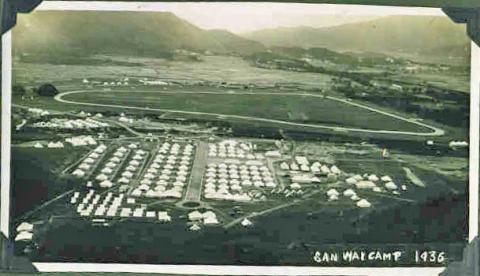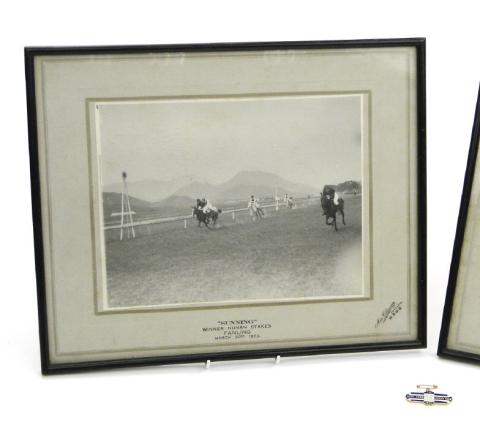Where: The back of this photo has a note that says we're looking at a training camp, but doesn't tell us anything more about its location.
Fortunately, IDJ has previously uploaded a similar view that tells us where it was taken.
San Wai is in the New Territories, northeast of Fanling.
.mapouter{position:relative;text-align:right;height:300px;width:100%;}.gmap_canvas {overflow:hidden;background:none!important;height:300px;width:100%;}
What: The San Wai training camp was run by the British Army. Another 1936 photo, taken in the opposite direction, shows that some of the different regiments that had trained here created copies of their badges on the hillside above the camp. The hill became known as Cap Badge Hill.
Returning to the main photo, the large, triangular outline on the flat land beyond the camp is the Kwanti Racecourse. You'll know of the Jockey Club's racecourse at Happy Valley, but from the 1920s until the 1940s, Hong Kong also had a second racecourse out here in the New Territories. It was run on a smaller scale, by the Fanling Hunt & Race Club.
Who: This area was inhabited long before the British arrived. When the British soldiers and jockeys first came here, they named their camp and racecourse after two existing villages in the area, San Wai to the west, and Kwan Ti Tsuen to the east.
Kwan Ti Tsuen is away to the left of the main photo and so can't be seen, but we should be able to see San Wai at the right edge of the main photo, as the village was next door to the race course. Unfortunately this photo isn't the sharpest, so I can't find any sign of it. Instead, we'll turn to "Map 1945" from the Hong Kong Maps website, where the village and the racecourse are clear to see.
The shape of the village - square, with a tower on each corner, and a moat around it - reminds me of the old castles we see in Britain, and sure enough this is one of the Hong Kong's walled villages. The other clue is the 'Wai' in its name - whenever you see that word in a local placename you can tell there's a walled village in its past. Even the look of the Chinese character for 'wai' gives you the feeling of the village's walls.
The other half of the village's name, 'San', means new. If you see a 'New ...' on a map there ls usually an 'Old...' nearby. The Cantonese word for old is 'Lo' and, sure enough, there's a Lo Wai just a short distance to the south of San Wai.
Both of them are walled villages, and both belong to the Tang Clan. The Tangs were the first of the clans to establish themselves in the New Territories, initially settling at Kam Tin over 1,000 years ago.
When: It'll help us put a date on the photo if we know the years that the racecourse and camp were in operation.
The earliest mention of the racecourse I've found in the newspapers is from 1926. Then it appears regularly through the 1930s until 1941 and the outbreak of war, as the newspapers reported races at the track. I don't see it mentioned again after the war though, and by the early 1950s the British Army had taken over the old racecourse site to use for a new barracks. I'll estimate the racecourse was in used from 1926-1941.
Turning to the Army's original camp under canvas, the earliest photo we have of it is from 1932, though it may well have been in operation earlier than that. We have several photos on Gwulo from the mid-1930s that look very similar to the main photo, so I'm guessing that's when it was taken too.
As always, corrections and additional facts / photos gratefully received!
Further reading:
- Photos of Kwanti Race Course and San Wai Camp
- Cap Badge Hill, and other British Military sites around Hong Kong in the 1950s
- Learn more about the Tang Clan in Hugh Baker's The Five Great Clans of the New Territories
- There are lots more old Hong Kong photos and their stories to enjoy in the three Gwulo books, Old Hong Kong Photos and The Tales They Tell, Volumes 1, 2, and 3
- Finally, now that the cooler autumn weather is finally here you might prefer to get out and explore this history in person. Both San Wai and Lo Wai are part of the Lung Yeuk Tau Heritage Trail.
Gwulo Photo ID: A413







Comments
Out of interest I came across
Out of interest I came across a similar photo of the camp on page 9 of The Hong Kong Sunday Herald of 1st February 1931 - we can assume for now that is the earliest date of a photo for the camp yet. The reproduction of the photo on the page is poor but the outline of the canvases of the camp is similar. It's not as extensive as the opening photo above so we can say your photo is after 1931.
The caption of the photo:
"MILITARY CAMP - Not an aerial photograph, but a snap taken by our photographer from a hill above Sun Wai, where the 2nd battalion the Argyll and Sutherland Highlanders has been under canvas. - (K. Fujiyama)"
There is also a photo of the signal section of the 2nd Batallion of the Argyll and Sutherland at Sun Wai on the same page by the same photographer.
Re: Early Photos of San Wai/Sun Wai Camp
Have seen photos of San Wai Camp from 1927/28. This webpage of the Queen's Royal Regiment shows an early photo of the camp from 1927.
The earliest reference of the use of Kwanti to accommodate additional troops can be found in the China Mail dated 14 February 1927.